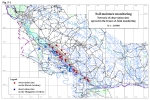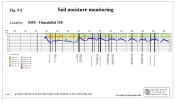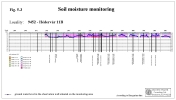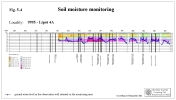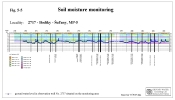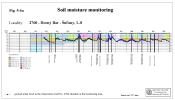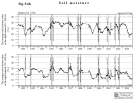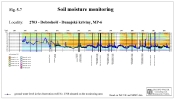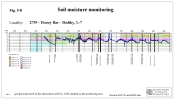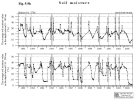PART 5
Soil Moisture MonitoringThe soil moisture monitoring in the hydrological year 2003 was performed according to the intergovernmental Agreement. Both sides carried out the measurements in the same way as in the previous years. The Slovak side measures the soil moisture by a neutron probe. The measurements are performed down to a prescribed depth or to the depth of the ground water level. The Hungarian side carried out the measurements with a capacity probe to the prescribed depth. The soil moisture on both sides is expressed by the total soil moisture content in volume percentage recorded in 10 cm depth interval for each measurement during the year. Measurements on the Slovak side were performed on 12 forest monitoring areas, on 5 biological monitoring areas and on 3 agricultural areas – Tab. 5-1. Measurements on the Hungarian side were performed on 9 forest monitoring areas and 5 agricultural areas - Tab. 5-2. The situation of observation objects is shown on Fig. 5-1. Table 5-1: List of monitoring stations on the Slovak side
Table 5-2: List of monitoring stations on the Hungarian side
5.2. Data presentation methods Both Parties presents the soil moisture in figures showing the average soil moisture content in volume percentage for the depth interval from 0 to 100 cm and from 110 to 200 cm. A small difference can occur in Hungarian data, where the value for depth interval under the 110 cm represents the average value for the rest of total measured depth (the average value can be calculated from less than 10 measured values). On colour figures the soil moisture time distribution for the whole measured depth is presented. The graphical presentation of the whole set of measured data is given in the Slovak and Hungarian National Annual Reports. 5.3. Evaluation of results on the Hungarian side The soil moisture measurements on the Hungarian side in 2003 continued at forestry monitoring sites in the floodplain area as well as at agricultural monitoring sites in the flood-protected area. The moisture conditions of soils are essentially influenced by the rainfall conditions, by the soil layer thickness and composition as well as by the ground water level position. The observed soil moisture values in 2003 were influenced by unfavourable rainfall distribution. The total amount of rainfall at the beginning of the year was low and reached only 40-60% of the long term average. The soil saturation by water at the beginning of the vegetation period reached 70-80%. Higher amount of rainfall occurred in May, June and July, however it was not sufficient as well and there were major differences in the spatial distribution. The soil moisture content continuously decreased and minimal values were reached in August and September when the rainfall conditions were very unfavourable. Partial replenishment of the soil moisture in the upper part of the soil layer was induced by precipitation in October, however the following two months were characterized by insufficient rainfall again. The soil moisture in the Szigetköz region was adversely influenced by the atypical flow rate regime in the Danube as well. While in the winter period (November 200- January 2003) several significant flood waves occurred, no flood or higher discharge occurred during the vegetation period. Moreover, from the middle of June till the middle of September unusually low flow rates were in the Danube. The average ground water level in the Upper part of Szigetköz lagged behind the average ground water level in 2002 by 7-25 cm, while in the middle part of Szigetköz it lagged behind the average water level in 2002 by 32-78 cm. The soil moisture on forestry monitoring sites For all soil moisture monitoring point on forestry areas it was characteristic that in the soil layer up to 1 m depth the maximum and average values of the soil moisture content were lower in comparison with the previous year. The minimal values were comparable or only slightly lower comparing to the previous year, because periods with critical lack of moisture occurred in both years. The highest average soil moisture contents in the layer down to 1 m depth on most observed sites were recorded at the first measurement cycle in the year 2003. Since then the soil moisture content continuously decreased and the lowest values occurred usually at the end of vegetation period. Similar situation arisen in the layer below 1 m depth, however on monitoring sites influenced by the water supply the groundwater in varying depth moisturized the soil - monitoring sites No. 9355, 9994, 9995 (Fig. 5-2, Fig. 5-4). The positive influence of the water supply on monitoring sites No. 9498, 9996 and 9997, which are situated closer to the Danube old riverbed, was limited because of the drainage effect. The drainage effect of the Danube old riverbed prevails on the monitoring site No. 9972. The forest monitoring site No. 9452 in the middle part of Szigetköz is situated near a water supply river branch and it was continuously moisturized by the ground water, however the ground water level was lower in comparison with the previous year (Fig. 5-3). The monitoring site No. 9998 is situated below the water supply system and the ground water level is influenced only by the water level fluctuation in Danube old riverbed. So, due to the unfavourable hydrological conditions the ground water level fluctuated much lower than in the previous year. The soil moisture on agricultural monitoring sites on the flood protected side The soil moisture at monitoring sites No. 2630 and 2653 in hydrological year 2003 was influenced by the precipitation only due to the deeply situated ground water level. Maximum soil moisture values were recorded at the beginning of measurement in 2003. At monitoring site 2630, situated near the Dunaremete gauging station on the Danube, continuous decrease of soil moisture values was observed. Although the ground water level at the monitoring site No. 2653 is situated deep, the soil moisture values both in the layer up to 1 m depth and below showed only very slight decrease. Monitoring sites No. 2605 and 9443 are situated in areas with thick covering layer. The ground water moisturised the bottom of soil layer during the whole year, however the rainfall influences the upper layer. The monitoring site No. 7920 is situated in the area where the drainage effect strongly influencing the ground water level. The surface water level is influenced by the backwater effect. Due to very low water levels in the Danube the ground water only moderately moisturised the thick covering layer. 5.4. Evaluation of results on the Slovak side Monitoring sites on the Slovak side are situated in the inundation area and flood-protected agricultural area (Fig. 5-1). According to the soil moisture observation at monitoring sites situated in the agricultural area (sites No. 2716, 2717, 2718) it can be stated that the soil moisture content during the whole observed period remained unchanged (Fig. 5-5). Only at the monitoring site No. 2718 the soil moisture content decreased significantly due to unfavourable climatic conditions. The position and fluctuation of ground water level remained unchanged as well. In the year 2003 the ground water level at the monitoring site No. 2716 fluctuated in the depth of 2.2-4 m, at site No. 2717 in the depth of 2-3.8 m and at site No. 2718 in the depth of 1.6-2.8 m. The fluctuation of soil moisture content in the depth interval from 0 to 1 m mostly depends on climatic conditions. In the depth from 1 to 2 m the soil moisture fluctuation, except the monitoring area No. 2716, is partly influenced by the ground water level. The soil moisture content in the depth to 1 m mostly fluctuated in the range from 7 to 18 % on the monitoring site No. 2716 and in the range from 19 to 32 % on the monitoring sites No. 2717 and 2718. In the depth between 1 and 2 m the soil moisture content mainly varied from 15 to 20 % on monitoring site No. 2716, in the range from 30 to 35 % on monitoring site No. 2717 and in the range from 12 to 26 % on monitoring site No.2718. The situation in the inundation area is more complex. Changes of the soil moisture content depend mainly on the location of the monitoring site in respect to the Danube, in respect to the river branch water supply and on the soil profile thickness. The soil moisture is besides the ground water level and precipitation highly dependent on natural or artificial floods. In hydrological year 2003 there were no flood, natural or artificial, in the area. During the winter period the moisture in soil profiles reached values comparable to previous years. Hydrological and climatic conditions were rather favourable, although the precipitation amount in February was very low. However, the precipitation in the following two months (March and April 2003) was low again. Since beginning the vegetation period the soil moisture started to decrease. The next three months (May, June and July 2003) were richer in precipitation, however the amount of water was not sufficient to supply the soil and the soil moisture decrease continued. August and September 2003 were dry and warm. The soil moisture reached values close to the lowest ones recorded during the whole period. Soil moisture was not supplied from the ground water as well, because of unusually low flow rates in the Danube during the whole vegetation period. These unfavourable hydrological and climatic conditions were partially reduced on areas were the water supply is applied. However, an artificial flooding of the inundation area would be the best solution. In the inundation area around Dobrohoą» and Bodíky villages is the thickness of the soil profile, similarly to the Hungarian side, low - monitoring sites No. 2703, 2764, 2763, 2762 and 2761. The ground water level in hydrological year 2003 fluctuated only in the gravel layer. The ground water level on the area No. 2703 fluctuated from 4 to 5 m, on the areas No. 2764, 2763, 2762 and 2761 changed from 2.5-4.5 m. The average values of the soil moisture content, both in the depth to 1 m and below, significantly fluctuated and they were highly dependent on the climatic conditions (Fig. 5-7). Maximal average soil moisture contents occurred in January 2003. During the vegetation period the soil moisture content, both in the layer down to 1 m depth and below, significantly decreased. Minimal values occurred at the end of October 2003. The thickness of the soil profile in the middle part of the inundation area is higher. In general the ground water regime in this region is influenced by the water supply of the river branch system, introduced in May 1993. Moreover, the natural or artificial floods are with high influence on the ground water level. The ground water level usually fluctuates mostly above the boundary between the soil profile and gravel layers - monitoring sites No. 2704, 2705, 2758, 2759, 2760 (Fig. 5-6a, Fig. 5-6b, Fig. 5-8). The lack of precipitation during the dry period in 2003 resulted in continuous decrease of the soil moisture content, both in the upper and lower part of the soil layer. The ground water supplied the soil profile in the depth below 2 m only. No natural or artificial occurred in 2003 so the soil profile were not supplied from the ground water. The maximal values of soil moisture content were reached in January 2003, minimal values mostly occurred at the end of the year. In the lower part of the inundation area, downstream of the confluence of river branch system and the Danube (monitoring sites No. 2706, 2756, 2755), the ground water level usually fluctuates around the boundary between the soil profile and the gravel layer. However, in 2003 due to low flow rates in the Danube the ground water level dropped by 1 m in comparison to the previous year and did not supplied the soil profile. The average values of the soil moisture significantly fluctuate, and are strongly dependent on the ground water level fluctuation. The minimum and maximum values are related to the minimum and maximum ground water levels respectively. In 2003 was the soil moisture negatively influenced by low water levels in the Danube and at the end of the vegetation period reached the lowest values ever recorded. (Fig. 5-9a, Fig. 5-9b). Minimal values of soil moisture in the layer down to 1 m depth occurred at the end of September and in the layer between 1 and 2 m depth at the end of the year. The soil moisture contents at monitoring sites No. 2707, 3804, 3805, located in the inundation below the confluence of the tailrace canal and the Danube old riverbed, are highly influenced by the flow rate regime in the Danube. The maximum values in the year 2003, in the depth down to 1 m and between 1 and 2 m, occurred in January, while the minimum values occurred at the end of vegetation period. The ground water level at monitoring site No. 2707 and 3804 fluctuated mostly in the depth 2.5-4.5 m, on the other site in the depth 0-2.8 m. These monitoring areas were negatively influenced by the low flow rates in the Danube similarly to the monitoring areas located in area influenced by the Gabčíkovo structures.
|
